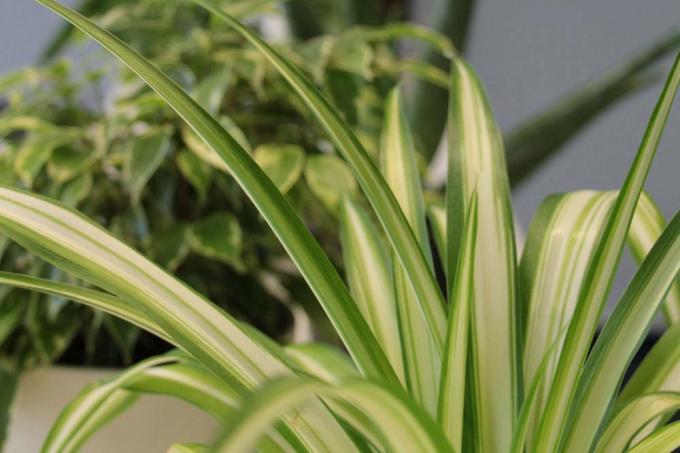
table of contents
- Indoor climate
- Hints
- Office plants
- Bow hemp
- Dragon tree
- Green lily
- Cacti
- Lucky Chestnut
- Orchids
- Hydroponics
Plants in the office sustainably improve the indoor climate and filter unhealthy pollutants from the air. In addition, they consume carbon dioxide and provide fresh oxygen for it, so that there is enough air to breathe. Furthermore, green plants reduce long-term stress and have been proven to increase the productivity of employees. When choosing the right plant varieties, the site conditions and the intensity of care must be taken into account. The easier to care for and more adaptable the houseplants are, the better they will thrive in the office.
Indoor climate
Indoor climate in the office
People spend a large part of their life at work, which is often in closed rooms. There, air conditioning and inadequate ventilation ensure a poor indoor climate, which is a long-term health hazard. The dry heating air in winter in particular weakens the immune system and irritates the respiratory tract. For this reason, a healthy working atmosphere is extremely important. Indoor plants are ideal for sustainably improving the indoor air quality in the office. These are a quick and easy method that is also relatively inexpensive. Very tall plants are ideal for open-plan offices, as they serve as privacy screens and create some privacy.
- Plants increase the humidity in offices
- consume carbon dioxide and produce oxygen
- Plants filter in pollutants from the indoor air
- bind airborne dust on their leaves
- Green plants promote concentration and reduce stress
- prevent signs of fatigue, skin irritation and headaches
- reduce the noise level in open-plan offices
- reduce temperature fluctuations
- Plants look decorative
Hints
When it comes to plants in offices, the problem quickly arises as to who will take care of them. Nobody is normally in the building on weekends and during the company holidays. Therefore, easy-care houseplants that have robust properties are to be preferred. If they get by with only a little water and minimal nutrients, then they can survive longer periods of drought. In addition, the site conditions also play a decisive role, which must be observed. Most plants can tolerate extremely strong sun just as little as too little light in shady locations. However, suitable plant varieties can also be found for these extreme conditions.
- Pay attention to easy-care and adaptable plant varieties
- Choose the right plant for the respective location
- East or west windows with many hours of sunshine are ideal
- Avoid direct sun and strong midday heat at the south window
- often insufficient sunlight at the north window
- Don't forget to water the plants, especially on hot and dry days
- organize casting representation during vacation times
Office plants
Areca palm
The areca palm is also known as the golden fruit palm and has the botanical name Dypsis lutescens. The plant comes from Madagascar and improves the quality of the indoor climate over the long term, as it releases a lot of moisture into its surroundings. In addition, the palm tree cleans polluted room air and provides fresh air to breathe. The areca palm grows much faster than other palm varieties and is therefore well suited as a room divider in larger offices. In addition, the palm forms several and curled trunks, so that only a few specimens form a small, tropical palm forest. If the incidence of light in the office is not even, then the plant should be rotated regularly and placed in the direction of the sun.
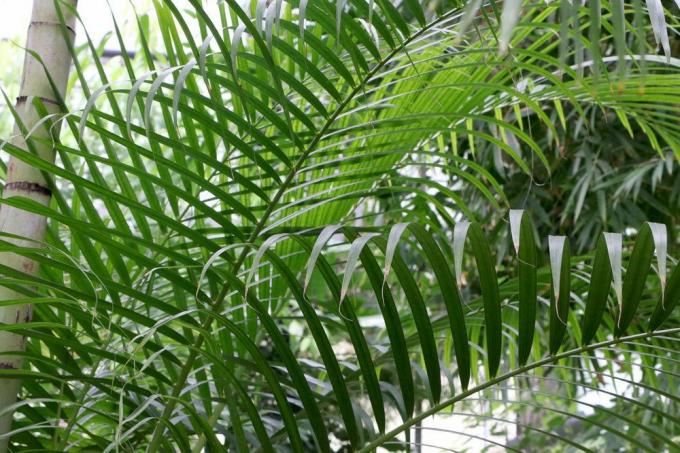
Care & location
- prefers bright, but not full sun, locations
- needs temperatures of at least 15 ° Celsius
- depends on high humidity
- Water generously with lime-free water from April to October
- Apply liquid fertilizer every 2 weeks
- Reduce watering units during winter and do not fertilize
- Spray regularly with lime-free water
- The ideal plant substrate is special palm soil
- Integrated breathing flakes prevent waterlogging and aerate the soil
Bow hemp
The bow hemp has the botanical name Sansevieria trifasciata and is a desert plant native to Africa. Due to its origin, the bow hemp is very warmth-loving and therefore adapts perfectly to interiors. The color of the leaves is green with a tinge of gray, but there are now also bright leaf colors with spots and stripes. The leaf margins are set off in yellow. The growth form is expressed in distinctive, strong and tapering leaf tongues. These elongated leaves seem to stick out of the earth and can grow up to a meter high. The Sansevieria trifasciata is an adaptable and frugal plant that copes well with neglect.
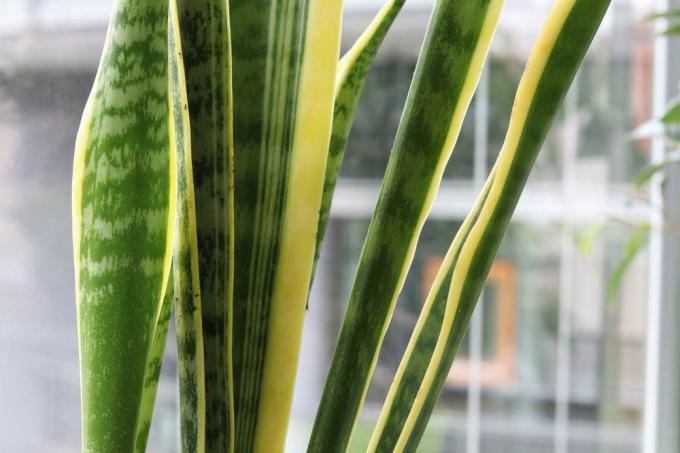
Care & location
- prefers bright locations, can also cope with partially shaded places
- grows slower in less light
- low water and nutrient requirements
- Leaves have succulent properties, store water
- Cactus soil is ideal as a plant substrate
- The growing season is May to October
- fertilize plants once a month during this time
- Use cactus fertilizer
- can stay in the same planter for several years
- produces a lot of oxygen at night
Dragon tree
The dragon tree has the botanical name Dracaena and is an agave family from the Canary Islands. But it also occurs in Madagascar and Asia. The color of the leaves is dark green, accented with a red border. The leaves grow narrow and sword-shaped, along a slender trunk. The growth form is reminiscent of palm trees and has branched areas. As a houseplant, the Dracaena reaches a maximum height of 1 m. The more pronounced the leaf markings, the more light the respective dragon tree can withstand. The plant is extremely robust and easy to care for, but needs more care in the summer months.
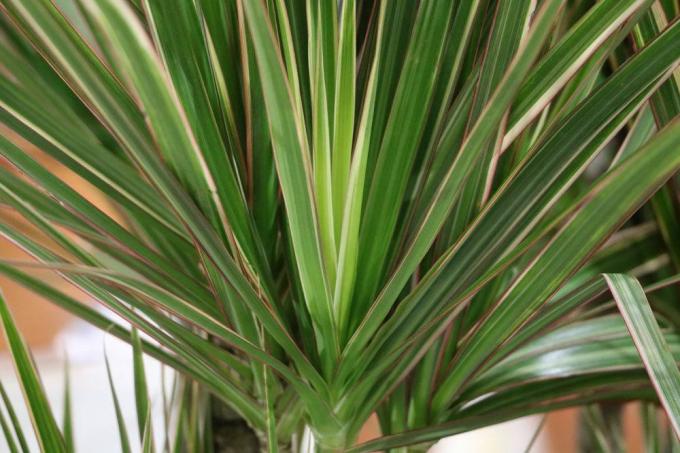
Care & location
- prefers bright locations
- can cope with direct sun after getting used to it
- also gets used to partially and fully shaded places
- Water sparingly, about 1-2 times a week
- keep a little more humid in summer and drier in winter
- Apply liquid fertilizer every 2 weeks from April to October
- relatively undemanding when it comes to the plant substrate
- good water permeability is important
- Loosen the earth with sand or clay granules
- needs temperature values between 19 ° and 25 ° Celsius
- does not tolerate temperatures below 10 ° Celsius
Green lily
The green lily has the botanical name Chlorophytum comosum and is an agave family native to South Africa. The color of the leaves is green in the wild; cultivated forms are also available with white or yellow stripes. The herbaceous plant forms clumps and has narrow leaves that can be up to 45 cm long. The Chlorophytum comosum comes into its own in a hanging basket, in which the overhanging tuft of leaves can spread indefinitely. It thrives both on the windowsill and on furniture around the window. The plant is very frugal both in terms of the location conditions and in terms of care.
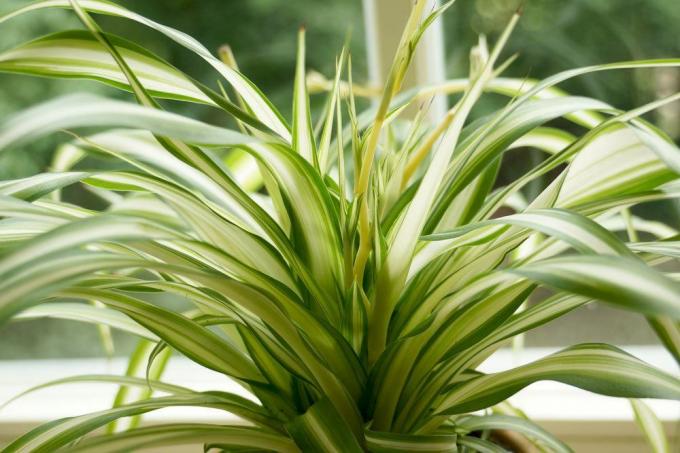
Care & location
- tolerates sunny as well as partially shaded and shady locations
- does not like extremely strong midday sun
- Water abundantly during the main growing season
- stores water in the roots, so it can withstand longer periods of drought
- Water more sparingly in winter
- Fertilize every 2-3 weeks, liquid fertilizer for potted plants is ideal
- needs normal room temperatures, also tolerates intense heat
- do not keep below 10 degrees
- Normal potting soil based on nutrient-rich compost is ideal
- when the root ball has strong roots, repot
Dieffenbachia
The Diefenbachia is an attractive ornamental foliage plant that forms thick stems that do not branch. The soft leaves have wrapped stems and a green base color, which is decorated with yellow or white markings. The cultivated forms are now available in different colors and decorations. The plant can grow up to a meter high, the cultivated forms become even larger. It comes from the dense rainforests of South and Central America and therefore gets by with little light. Due to the large leaf areas, the Diefenbachia ensures good air purification.
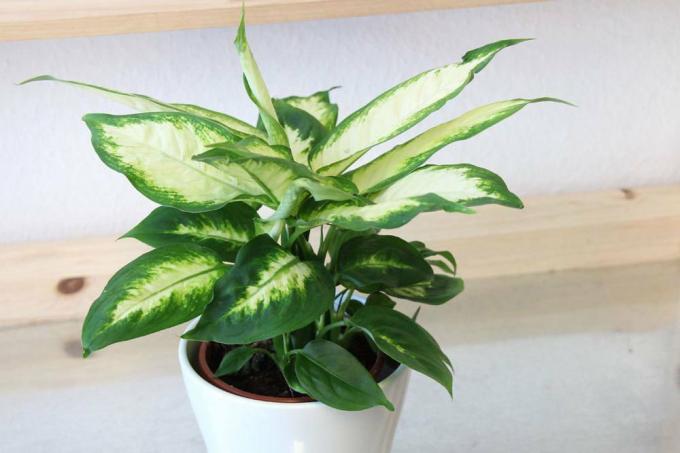
Care & location
- gets along with light to partially shaded locations
- Avoid direct midday sun
- Water regularly during the growing season
- does not tolerate extreme drought or waterlogging
- Apply liquid fertilizer once a week from April to August
- fertilize less and water less in winter
- Use normal potting soil as a plant substrate
- Repot about every three to four years
- needs temperature values around 20 ° Celsius
- does not tolerate temperatures below 15 ° Celsius in the long term
Cacti
Cacti have the scientific name Cactaceae and are originally found in the desert regions of the world. For this reason, the robust plants thrive best in intense and direct sunlight. An ideal location is therefore an office window facing south, where the sun shines all day. Since cacti grow very slowly, they take up little space. In addition, the desert plants are extremely frugal and can cope with nutrient-poor substrates. Low air circulation and drying out are also not a big problem for the plant, as it stores water for times of need. Popular species include the columnar cactus, the rock cactus and the spherical cactus.
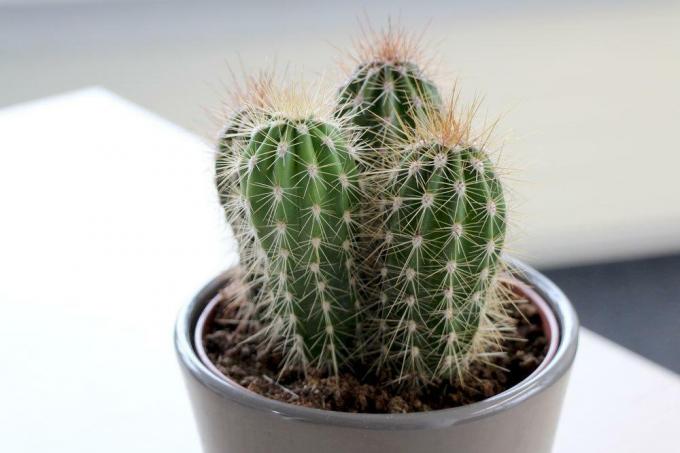
Care & location
- prefer direct sun to partially shaded location conditions
- Water regularly but sparingly in summer
- Let the pads dry out completely between waterings
- Complete setting of casting units from November
- Use special cactus fertilizer every month during the main growing season
- Cactus soil is suitable as a plant substrate
- Mix the potting soil with sand
- needs normal room temperature
- Temperature values must not fall below 15 ° Celsius
Zamie, Zamioculcas
The Zamioculcas zamiifolia comes from East Africa and is therefore familiar with warm regions. In its country of origin, the plant is used to getting by with a small water supply. In addition, the Zamioculcas does not make great demands on the lighting conditions and thrives even in shady corners. The zamie forms strong rhizomes, from which the graceful-looking pinnate leaves grow. The robust houseplant is also forgiving of gross care mistakes and is therefore ideally suited for keeping in offices. However, the zamie is susceptible to pests in dry heating air and should therefore be checked regularly for it. In addition, all parts of the plant are poisonous, so gloves and, if necessary, eye protection should be worn during care.
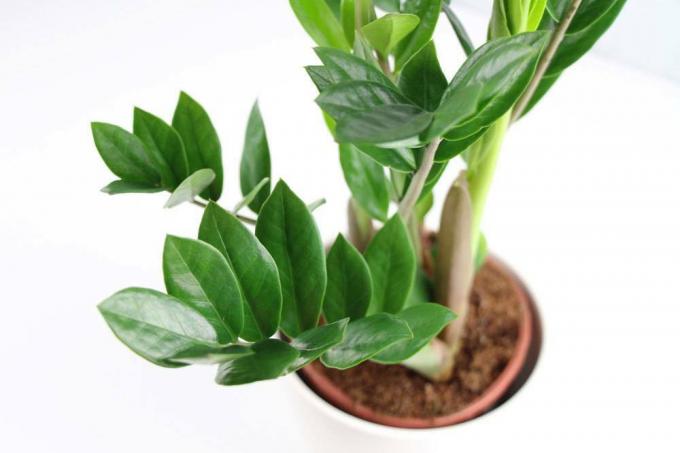
Care & location
- thrives in almost all lighting conditions
- bright locations increase the rate of growth
- darker places ensure intense green leaf colors
- however, does not tolerate direct sunlight
- Temperatures should be at least 16 ° Celsius
- may move outdoors in summer
- palm soil is the ideal plant substrate
- Alternatively, compost-based potting soil is possible
- Mix in clay granules for improved permeability
- water regularly, always keep slightly moist
- Fertilize every month during the growing season
Lucky Chestnut
The lucky chestnut bears the botanical name Pachira aquatica and does not make great demands on care. This is why the robust houseplant is ideal for the office. Thanks to its striking growth and large leaves, the lucky chestnut fits perfectly on window sills and as a room divider in open-plan offices. The plant forgives small care mistakes, but attaches importance to a suitable location and a good plant substrate. The evergreen deciduous tree has a slightly thickened trunk foot, which serves as a water reservoir, so that dry periods are well tolerated. However, the Pachira aquatica needs a high level of humidity, in return it is not susceptible to most diseases and pests.
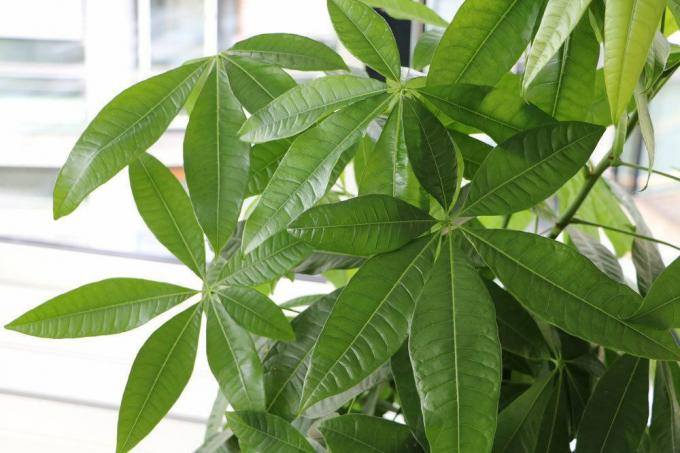
Care & location
- needs light and warm location conditions
- Temperature values should not fall below 12 ° Celsius
- may move outdoors in summer
- needs a sheltered location, not in full sun
- well-drained and loose plant substrate, not very rich in nutrients
- a few watering units, but watering them extensively
- Avoid waterlogging at all costs
- Spray as often as possible with lime-free water
- Fertilize every 2 weeks during the growing season
- Apply fertilizer in a reduced dose
Orchids
Orchids belong to the Orchidaceae family of plants and come mainly from tropical countries. Thanks to the robust and easy-to-care-for cultivation hybrids, orchids are now also suitable as office plants. The perennial and herbaceous flowering plants are a beautiful decoration for the office window, as well as for the reception area and reception. In the tropics, the plants grow in the shade of trees, usually as epiphytes, so that they can also cope with darker site conditions. There are now more than 1,000 genera worldwide with a multitude of shapes and impressive flower colors.
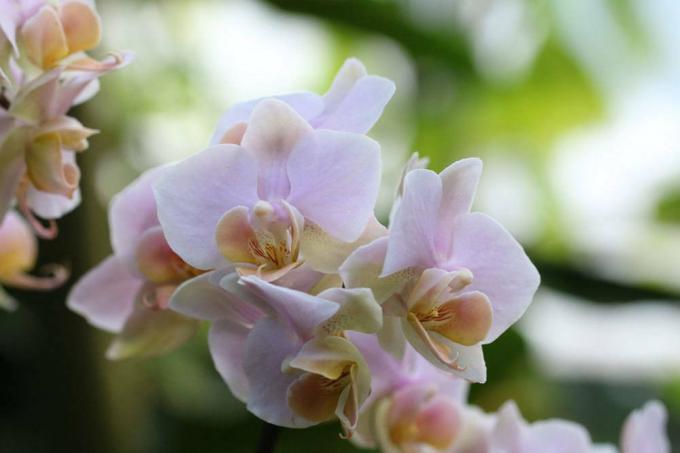
Care & location
- light to partially shaded site conditions
- do not tolerate blazing sun
- do not set up in the immediate vicinity of radiators
- Plant substrate with pieces of bark, organic and inorganic components
- Water twice a week in summer and once a week in winter
- The need for watering is indicated by a light pot
- always water thoroughly
- only use lime-free water
- Fertilize every 2 weeks during the growing season and flowering period
- Special fertilizer for orchids is ideal
- needs humidity of more than 60 percent
- spray in between
- requires temperature values of 19-25 ° Celsius
A leaf
The single leaf bears the botanical name Spathiphyllum and convinces as a robust plant. It also thrives in offices where there are only a few hours of sunshine a day. However, the plant does not tolerate air conditioning so well and the dry air that comes with it. The single leaf forgives short-term dry periods, but it prefers a always slightly moist root ball. If the location is right, the plant is very easy to care for and produces decorative flowers almost all year round. There are many varieties to choose from, which differ in terms of height and flowers.
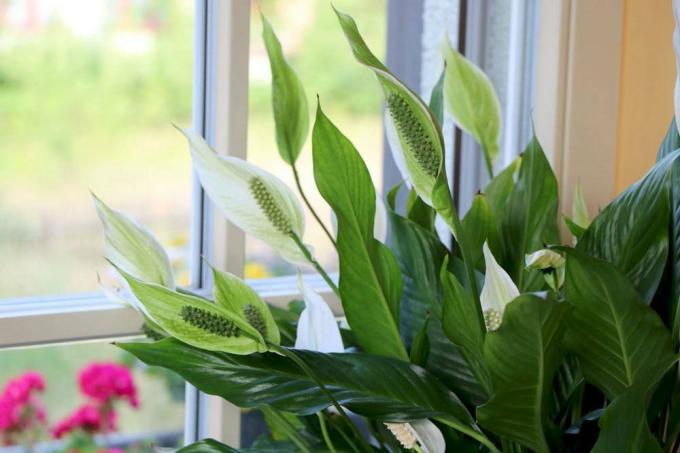
Care & location
- prefers partially shaded site conditions
- direct sunlight is to be avoided
- needs high humidity
- ideally spray with lime-free water in between
- Water moderately 2 times a week
- Waterlogging is temporarily tolerated
- Use low-dose liquid fertilizer every month
- produces decorative flowers even in winter
- Normal potting soil with clay granulate is suitable as a plant substrate
- room temperatures are optimal
- Temperature values must not fall below 13 ° Celsius
Hydroponics
When keeping office plants, there are always phases in which nobody can take care of the plants. This includes especially the weekends and vacation times, but general responsibility can also be a problem. This is why hydroponics is a good choice, literally translated this term stands for culture with water. The system is easier to care for than conventional cultivation and provides safe long-term maintenance for many plants. The earth is completely replaced by a special culture substrate, which mainly consists of a high-performance expanded clay. This makes it much easier to keep indoor plants, as they have to be watered less often. In this way, longer vacation stays are possible, in which no one can take care of the office plants.
- Cultivation of plants in water
- almost every type of plant is suitable for hydroponics
- significantly lower frequency of the casting processes
- it only needs to be watered about every 2 weeks
- practical water level indicator
- shows the dosage and frequency of the irrigation water
- Inorganic materials are replacing earth
- alternative growing media are basalt, expanded clay, gravel and mineral wool
- Plant replaces normal roots with water roots
- Nutrient solution provides moisture and nutrients



